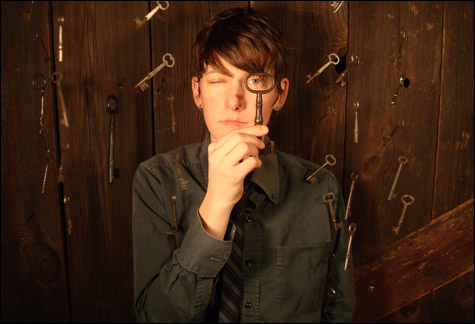
HAPPY FEAT: Northampton singer-songwriter Chris Pureka writes the kind of music that can make you happy to be sad — or just plain happy. |
There’s nothing like getting socked in the head with a big fat metaphor — and if it’s carried along by some solid guitar playing, so much the better. Last year, Neko Case’s tornado got us; this year, it might very well be Chris Pureka’s wrecking ball. Somehow, she condenses all of your relationships, political battles, work woes, and nagging worries into one dense object, and one great song.
“I have a joke that I usually put one happy song on each record,” says the young Northampton-based singer-songwriter, who comes to the Middle East this Friday. But no matter how many troubling things Pureka (rhymes with eureka) squeezes into her material, they manage to find permanent homes within her idiosyncratic melodies. “This is the kind of music that I want to be making.” It’s also the kind of music that can make you happy to be sad — or just plain happy.
So smile — you’re about to get hit in the face. “Wrecking Ball,” the first song off Pureka’s new How I Learned To See in the Dark (Sad Rabbit), opens with ominous clouds of feedback before breaking into the resentful strum of an acoustic guitar and icy chords caught in clanking off-beats. And that’s just the guitars.
“The imagery is pretty loaded,” she explains. Foreboding images of shipwrecks, anchors, barns, hangmen, and broken clocks occupy How I Learned To See in the Dark’s emotionally charged landscape, which is located somewhere between American Gothic and The Twilight Zone. But Pureka is more Rod Stewart than Rod Serling. She’s an accomplished folk/roots guitarist (both solo live and in the studio), and she also possesses the tense, sultry voice and commanding presence of a true frontwoman.
“I’m sort of letting loose more,” she continues. “The older records feel reined in.” “Broken Clock” finds the hushed singer in resplendent Stevie Nicks mode. As she and her band storm through this dark minor-key vamp, it’s hard not to hear forlorn shades of “Rhiannon,” only with a fiddle instead of a Rhodes.
Pureka was drawn to songwriting from a place of terrible shyness, and she attributes her audience connection to having avoided many of the compromises and complications that come with management and labels. “You hear it all the time in the music business, where people are a 10-year overnight success. It’s a conscious choice to do it this way. It’s definitely a different path, and I see things happening faster for other people. But I have a dedicated, established fan base all over the country that I earned with my beating-the-pavement style. And most days, it’s still really fun, and I have to remember that.”
This time around, she’s bringing a five-piece group, in the hope of re-creating some of the atmosphere and dynamics of the new album. It’ll be a departure from the conversational music she’s been playing to coffeehouse and sit-down audiences since breaking out with 2004’s Driving North. All the rustic imagery is still there, but she now uses words as symbols rather than signposts. “People come to pay attention — the lyrics are a big part of it. This wasn’t intended to be a folk record. This to me feels a little more cryptic.”